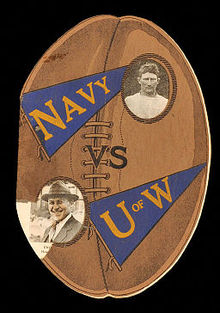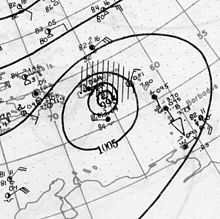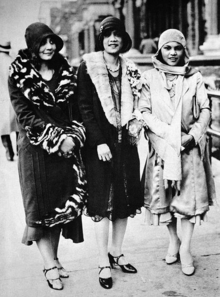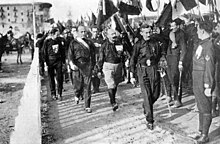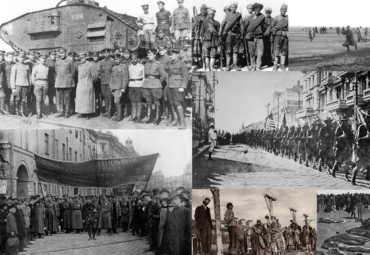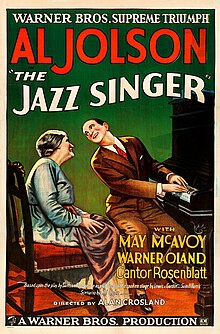Portal:1920s/Selected article
historical reference. . Either the page is no longer relevant or consensus on its purpose has become unclear. To revive discussion, seek broader input via a forum such as the village pump |
| Note: Article entries are now being transcluded directly on the main portal page. However, this page should be retained for historical reference. |

Art Deco, short for the French Arts décoratifs (lit. 'Decorative Arts'), is a style of visual arts, architecture, and product design, that first appeared in Paris in the 1910s (just before World War I), and flourished in the United States and Europe during the 1920s to early 1930s. Through styling and design of the exterior and interior of anything from large structures to small objects, including how people look (clothing, fashion, and jewelry), Art Deco has influenced bridges, buildings (from skyscrapers to cinemas), ships, ocean liners, trains, cars, trucks, buses, furniture, and everyday objects including radios and vacuum cleaners.
Art Deco got its name after the 1925 The Golden Twenties was a particular vibrant period in the history of Berlin. After the Greater Berlin Act, the city became the third largest municipality in the world and experienced its heyday as a major world city. It was known for its leadership roles in science, the humanities, art, music, film, architecture, higher education, government, diplomacy and industries. (Full article...) Western fashion in the 1920s underwent a modernization. For women, fashion had continued to change away from the extravagant and restrictive styles of the Victorian and Edwardian periods, and towards looser clothing which revealed more of the arms and legs, that had begun at least a decade prior with the rising of hemlines to the ankle and the movement from the S-bend corset to the columnar silhouette of the 1910s. Men also began to wear less formal daily attire and athletic clothing or 'Sportswear' became a part of mainstream fashion for the first time.
The 1920s are characterized by two distinct periods of fashion: in the early part of the decade, change was slower, and there was more reluctance to wear the new, revealing popular styles. From 1925, the public more passionately embraced the styles now typically associated with the Roaring Twenties. These styles continued to characterize fashion until the worldwide depression worsened in 1931. (Full article...) The 1923 FA Cup final was an association football match between Bolton Wanderers and West Ham United on 28 April 1923 at the original Wembley Stadium in London. The showpiece match of English football's primary cup competition, the Football Association Challenge Cup (better known as the FA Cup), it was the first football match to be played at Wembley Stadium. King George V was in attendance to present the trophy to the winning team.
Each team had progressed through five rounds to reach the final. Bolton Wanderers won 1–0 in every round from the third onwards, and David Jack scored the lone goal each time. West Ham United faced opposition from the Second Division or lower in each round, the first time this had occurred since the introduction of multiple divisions in the Football League. West Ham took three attempts to defeat Southampton in the fourth round but then easily defeated Derby County in the semi-final, scoring five goals. (Full article...) The 1924 Rose Bowl was a postseason American college football bowl game played between the independent Navy Midshipmen and the Washington Huskies, a member of the Pacific Coast Conference (PCC). The game took place on January 1, 1924, at the Rose Bowl stadium in Pasadena, California, closing the 1923 college football season. The game opened in front of approximately 40,000 people and ended in a 14–14 tie. It was the first post-season bowl game for both teams. The 1924 game was the tenth edition of the Rose Bowl, which had first been played in 1902. Following the inaugural game's blowout score, football was replaced with chariot races until 1916. The Rose Bowl stadium had been constructed in 1923, making this edition the second game played in the arena.
The game's organizers had previously selected a team from the East Coast and the West Coast, and asked the Washington Huskies to represent the West Coast. Washington requested that the Navy Midshipmen be their opponents, and Navy accepted. Washington selected Navy in favor of several teams from the east which had amassed better records. Both teams had suffered only a single loss during the season, but Washington had won eight games compared with Navy's five, although Navy had also amassed two ties. Predictions gave Washington a slight advantage in the game due to the weight difference between the teams: the Washington players were on average 10 pounds (4.5 kg) heavier than those of Navy. (Full article...) The 

When it was held, the games were not formally recognised as being the Olympics, but acknowledged that they were held under the "high patronage of the International Olympic Committee". Partly due to this, varying figures are reported for the number of participants. The International Olympic Committee (IOC) website suggests that 258 athletes from 16 nations participated in 16 events across 9 sports. In contrast, the Sports-Reference website lists 313 participants from 19 countries. Bill Mallon, a prominent Olympic Games historian, quotes a figure of 291 competitors in his Historical Dictionary of the Olympic Movement. Meanwhile, the official report for the 1924 Summer and Winter Olympics listed 293 athletes from 17 nations. (Full article...)
The 1926 World Series was the championship series of the 1926 Major League Baseball season. The 23rd edition of the Series, it pitted the National League champion St. Louis Cardinals against the American League champion New York Yankees. The Cardinals defeated the Yankees four games to three in the best-of-seven series, which took place from October 2 to 10, 1926, at Yankee Stadium and Sportsman's Park.
This was the first World Series appearance (and first National League pennant win) for the Cardinals, and would be the first of 11 World Series championships in Cardinals history. The Yankees were playing in their fourth World Series in six years after winning their first American League pennant in 1921 and their first world championship in 1923. They would play in another 36 World Series (and win 26 of those), as of the end of the 2023 season. (Full article...)
The Okeechobee hurricane of 1928, also known as the San Felipe Segundo hurricane, was one of the deadliest hurricanes in the recorded history of the North Atlantic basin, and the fourth deadliest hurricane in the United States, only behind the 1900 Galveston hurricane, 1899 San Ciriaco hurricane, and Hurricane Maria. The hurricane killed an estimated 2,500 people in the United States; most of the fatalities occurred in the state of Florida, particularly in Lake Okeechobee. It was the fourth tropical cyclone, third hurricane, the only major hurricane of the 1928 Atlantic hurricane season, and remains the deadliest disaster in Florida’s history to date. It developed off the west coast of Africa on September 6 as a tropical depression, but it strengthened into a tropical storm later that day, shortly before passing south of the Cape Verde islands. Further intensification was slow and halted late on September 7. About 48 hours later, the storm strengthened and became a Category 1 hurricane on the Saffir–Simpson hurricane wind scale. Still moving westward, the system reached Category 4 intensity before striking Guadeloupe on September 12, where it brought great destruction and resulted in 1,200 deaths. The islands of Martinique, Montserrat, and Nevis also reported damage and fatalities, but not nearly as severe as in Guadeloupe.
Around midday on September 13, the storm strengthened into a Category 5 hurricane and peaked with sustained winds of 160 mph (260 km/h). About six hours later, the system made landfall in Puerto Rico; it remains the only tropical cyclone on record to strike the island at Category 5 intensity. Very strong winds resulted in severe damage in Puerto Rico; 24,728 homes were destroyed and 192,444 were damaged throughout the island, leaving over 500,000 people homeless. Heavy rainfall also led to extreme damage to vegetation and agriculture. On Puerto Rico alone, there were 312 deaths and about US$50 million ($887 million today) in damage. While crossing the island and emerging into the Atlantic, the storm weakened slightly, falling to Category 4 intensity. It began crossing through the Bahamas on September 16, where it resulted in 18 fatalities. (Full article...)
The 1st Academy Awards ceremony, presented by the Academy of Motion Picture Arts and Sciences (AMPAS) and hosted by AMPAS president Douglas Fairbanks, honored the best films from 1 August 1927 to 31 July 1928 and took place on May 16, 1929, at a private dinner held at the Hollywood Roosevelt Hotel in Los Angeles, California. Tickets cost $5 ($89 in 2023, considering inflation); 270 people attended the event, which lasted 15 minutes. It is the only Academy Awards ceremony not broadcast on either radio or television; a radio broadcast was introduced for the 2nd Academy Awards.
During the ceremony, AMPAS presented
Authors whose work appeared in Amazing Stories Quarterly include
The Années folles (French pronunciation: [ane fɔl], "crazy years" in French) was the decade of the 1920s in France. It was coined to describe the social, artistic, and cultural collaborations of the period. The same period is also referred to as the Roaring Twenties or the Jazz Age in the United States. In Germany, it is sometimes referred to as the Golden Twenties because of the economic boom that followed World War I. (Full article...)
The
The first phase of the battle began on August 13 with a frontal assault by the Red Army on the Praga bridgehead. The Russian forces captured Radzymin on August 14 and breached the lines of the 1st Polish Army, which was defending Warsaw from the east. Radzymin changed hands several times in heavy combat. Foreign diplomats, with the exception of the British and Vatican ambassadors, hastily left Warsaw. (Full article...)
The origins of the estate reach back to the 14th century; in 1382, the property then called Well-street was owned by William-at-Well. It passed through various owners and in 1836 was auctioned, as a substantial brick-built manor. In 1848, it was purchased by
The Chinese Civil War was fought between the Kuomintang-led government of the Republic of China and the forces of the Chinese Communist Party (CCP), with armed conflict continuing intermittently from 1 August 1927 until 7 December 1949, resulting in a CCP victory and control of mainland China in the Chinese Communist Revolution
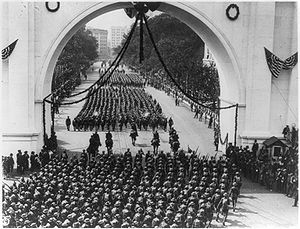
The Depression of 1920–1921 was a sharp deflationary recession in the United States, United Kingdom and other countries, beginning 14 months after the end of World War I. It lasted from January 1920 to July 1921. The extent of the deflation was not only large, but large relative to the accompanying decline in real product.
There was a two-year
Flappers were a subculture of young Western women prominent after the First World War and through the 1920s who wore short skirts (knee height was considered short during that period), bobbed their hair, listened to jazz, and flaunted their disdain for prevailing codes of decent behavior. Flappers were seen as brash for wearing excessive makeup, drinking alcohol, smoking cigarettes in public, driving automobiles, treating sex in a casual manner, and otherwise flouting social and sexual norms. As automobiles became more available, flappers gained freedom of movement and privacy.
Flappers are icons of the Roaring Twenties, a period of postwar social and political turbulence and increased transatlantic cultural exchange, as well as of the export of American jazz culture to Europe. More conservative people, who belonged mostly to older generations, reacted with claims that the flappers' dresses were "near nakedness" and that flappers were "flippant", "reckless", and unintelligent. (Full article...)
Part of a larger beautification plan for the Midway Plaisance, Time was constructed from a new type of molded, steel-reinforced concrete that was claimed to be more durable and cheaper than alternatives. It was said to be the first of any kind of finished work of art made of concrete. Before the completion of
In the United States, the Great Depression began with the Wall Street Crash of October 1929 and then spread worldwide. The nadir came in 1931–1933, and recovery came in 1940. The stock market crash marked the beginning of a decade of high unemployment, poverty, low profits, deflation, plunging farm incomes, and lost opportunities for economic growth as well as for personal advancement. Altogether, there was a general loss of confidence in the economic future.
The usual explanations include numerous factors, especially high consumer debt, ill-regulated markets that permitted overoptimistic loans by banks and investors, and the lack of high-growth new industries. These all interacted to create a downward economic spiral of reduced spending, falling confidence and lowered production.
Industries that suffered the most included construction, shipping, mining, logging, and agriculture. Also hard hit was the manufacturing of durable goods like automobiles and appliances, whose purchase consumers could postpone. The economy hit bottom in the winter of 1932–1933; then came four years of growth until the recession of 1937–1938 brought back high levels of unemployment. (Full article...)
The
Though it was centered in the Harlem neighborhood, many
The IG Farben Building – also known as the Poelzig Building and the Abrams Building, formerly informally called The Pentagon of Europe – is a building complex in Frankfurt, Germany, which currently serves as the main structure of the Westend Campus of the University of Frankfurt. Construction began in 1928 and was complete in 1930 as the corporate headquarters of the IG Farben conglomerate, then the world's largest chemical company and the world's fourth-largest company overall.
The building's original design in the
The Irish Civil War (Irish: Cogadh Cathartha na hÉireann; 28 June 1922 – 24 May 1923) was a conflict that followed the Irish War of Independence and accompanied the establishment of the Irish Free State, an entity independent from the United Kingdom but within the British Empire.
The civil war was waged between the Provisional Government of Ireland and the anti-Treaty Irish Republican Army (1922–1969) (IRA) over the Anglo-Irish Treaty. The Provisional Government (which became the Free State in December 1922) supported the terms of the treaty, while the anti-Treaty opposition saw it as a betrayal of the Irish Republic that had been proclaimed during the Easter Rising of 1916. Many of the combatants had fought together against the British in the Irish Republican Army (1919–1922) during the War of Independence, and had divided after that conflict ended and the treaty negotiations began. (Full article...)
The Jazz Age was a period in the 1920s and 1930s in which jazz music and dance styles gained worldwide popularity. The Jazz Age's cultural repercussions were primarily felt in the United States, the birthplace of jazz. Originating in New Orleans as mainly sourced from the culture of African Americans, jazz played a significant part in wider cultural changes in this period, and its influence on popular culture continued long afterwards.
The Jazz Age is often referred to in conjunction with the
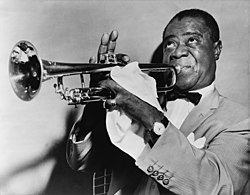
Jazz standards are musical compositions that are widely known, performed and recorded by jazz artists as part of the genre's musical repertoire. This list includes compositions written in the 1920s that are considered standards by at least one major book publication or reference work. Some of the tunes listed were already well-known standards by the 1930s, while others were popularized later. The time of the most influential recordings of a song, where appropriate, is indicated on the list.
A period known as the "

The 1928 Winter Olympics, referred to by the International Olympic Committee (IOC) as the II Olympic Winter Games, were held in St. Moritz, Switzerland, from February 11 through February 18, 1928. A total of 464 athletes from 25 National Olympic Committees (NOCs) participated in these Games. Overall, 14 events were contested in 8 disciplines. Athletes competed in skeleton for the first time, but unlike the previous Olympic Games there was no curling competition and military patrol was a demonstration event rather than a medal event. Both men and women competed in these Games, although women were only allowed to compete in the figure skating ladies' singles and pairs events.
Eighty-three individual athletes won medals, but the ones representing Norway far surpassed their competitors in the medal count, winning fifteen medals to the six won by the nearest NOC, the United States. The only three other NOCs that had medalists in more than one event were Sweden, Finland, and Austria. Twelve of the 25 participating NOCs secured at least one medal, and among these, six NOCs won at least one gold medal. (Full article...)
The Lost Generation is the demographic cohort that reached early adulthood during World War I, and preceded the Greatest Generation. The social generation is generally defined as people born from 1883 to 1900, coming of age in either the 1900s or the 1910s. The term is also particularly used to refer to a group of American expatriate writers living in Paris during the 1920s. Gertrude Stein is credited with coining the term, and it was subsequently popularised by Ernest Hemingway, who used it in the epigraph for his 1926 novel The Sun Also Rises: "You are all a lost generation." "Lost" in this context refers to the "disoriented, wandering, directionless" spirit of many of the war's survivors in the early postwar period. In the wake of the Industrial Revolution, Western members of the Lost Generation grew up in societies that were more literate, consumerist, and media-saturated than ever before, but which also tended to maintain strictly conservative social values. Young men of the cohort were mobilized on a mass scale for World War I, a conflict that was often seen as the defining moment of their age group's lifespan. Young women also contributed to and were affected by the war, and in its aftermath gained greater freedoms politically and in other areas of life. The Lost Generation was also heavily vulnerable to the Spanish flu pandemic and became the driving force behind many cultural changes, particularly in major cities during what became known as the Roaring Twenties. (Full article...)
The 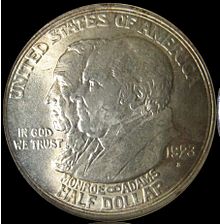
The Monroe Doctrine Centennial half dollar was a fifty-cent piece struck by the United States Bureau of the Mint. Bearing portraits of former U.S. Presidents James Monroe and John Quincy Adams, the coin was issued in commemoration of the centennial of the Monroe Doctrine and was produced at the San Francisco Mint in 1923. Sculptor Chester Beach is credited with the design, although the reverse closely resembles an earlier work by Raphael Beck.
In 1922, the motion picture industry was faced with a number of scandals, including manslaughter charges against star Roscoe "Fatty" Arbuckle. Although Arbuckle was eventually acquitted, motion picture executives sought ways of getting good publicity for Hollywood. One means was an exposition, to be held in Los Angeles in mid-1923. To induce Congress to issue a commemorative coin as a fundraiser for the fair, organizers associated the exposition with the 100th anniversary of the Monroe Doctrine, and legislation for a commemorative half dollar for the centennial was passed. (Full article...)
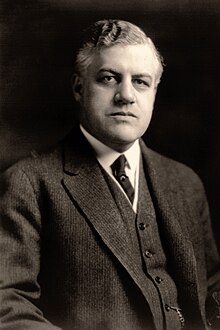
The Palmer Raids were a series of raids conducted in November 1919 and January 1920 by the United States Department of Justice under the administration of President Woodrow Wilson to capture and arrest suspected socialists, especially anarchists and communists, and deport them from the United States. The raids particularly targeted Italian immigrants and Eastern European Jewish immigrants with alleged leftist ties, with particular focus on Italian anarchists and immigrant leftist labor activists. The raids and arrests occurred under the leadership of Attorney General A. Mitchell Palmer, with 6,000 people arrested across 36 cities. Though 556 foreign citizens were deported, including a number of prominent leftist leaders, Palmer's efforts were largely frustrated by officials at the U.S. Department of Labor, which had authority for deportations and objected to Palmer's methods.
The Palmer Raids occurred in the larger context of the
The Progressive Era (1896–1917) was a period in the United States during the early 20th century of widespread social activism and political reform across the country that focused on defeating corruption, monopoly, waste, and inefficiency. The main themes ended during American involvement in World War I (1917–1918) while the waste and inefficiency elements continued into the 1920s. Progressives sought to address the problems caused by rapid industrialization, urbanization, immigration, and political corruption; and by the enormous concentration of industrial ownership in monopolies. They were alarmed by the spread of slums, poverty, and the exploitation of labor. Multiple overlapping progressive movements fought perceived social, political and economic ills by advancing democracy, scientific methods, professionalism and efficiency; regulating businesses, protecting the natural environment, and improving working conditions in factories and living conditions of the urban poor. Spreading the message of reform through mass-circulation newspapers and magazines by "probing the dark corners of American life" were investigative journalists known as "muckrakers". The main advocates of progressivism were often middle-class social reformers.
Corrupt and undemocratic

The Prohibition era was the period from 1920 to 1933 when the United States prohibited the production, importation, transportation and sale of alcoholic beverages. The alcohol industry was curtailed by a succession of state legislatures, and finally ended nationwide under the Eighteenth Amendment to the United States Constitution, ratified on January 16, 1919. Prohibition ended with the ratification of the Twenty-first Amendment, which repealed the Eighteenth Amendment on December 5, 1933.
Led by
The Rif War (Spanish: Guerra del Rif) was an armed conflict fought from 1921 to 1926 between the occupying colonialists of Spain (joined by France in 1924) and the Berber tribes of the mountainous Rif region of northern Morocco. The Rif Republic alone was able to keep a European middle power and great power in check for a time.
Led by
The Roaring Twenties, sometimes stylized as Roaring '20s, refers to the 1920s decade in music and fashion, as it happened in Western society and Western culture. It was a period of economic prosperity with a distinctive cultural edge in the United States and Europe, particularly in major cities such as Berlin, Buenos Aires, Chicago, London, Los Angeles, Mexico City, New York City, Paris, and Sydney. In France, the decade was known as the années folles ('crazy years'), emphasizing the era's social, artistic and cultural dynamism. Jazz blossomed, the flapper redefined the modern look for British and American women, and Art Deco peaked.
The social and cultural features known as the Roaring Twenties began in leading metropolitan centers and spread widely in the aftermath of World War I. The spirit of the Roaring Twenties was marked by a general feeling of novelty associated with modernity and a break with tradition, through modern technology such as automobiles, moving pictures, and radio, bringing "modernity" to a large part of the population. Formal decorative frills were shed in favor of practicality in both daily life and architecture. At the same time, jazz and dancing rose in popularity, in opposition to the mood of World War I. As such, the period often is referred to as the Jazz Age. (Full article...)
The Russian Civil War was a multi-party civil war in the former Russian Empire sparked by the overthrowing of the social-democratic Russian Provisional Government in the October Revolution, as many factions vied to determine Russia's political future. It resulted in the formation of the Russian Socialist Federative Soviet Republic and later the Soviet Union in most of its territory. Its finale marked the end of the Russian Revolution, which was one of the key events of the 20th century.
The Russian monarchy ended with the abdication of Tsar Nicholas II during the February Revolution, and Russia was in a state of political flux. A tense summer culminated in the October Revolution, where the Bolsheviks overthrew the provisional government of the new Russian Republic. Bolshevik seizure of power was not universally accepted, and the country descended into civil war. The two largest combatants were the Red Army, fighting for the establishment of a Bolshevik-led socialist state headed by Vladimir Lenin, and the loosely allied forces known as the White Army, which functioned as a political big tent for right- and left-wing opposition to Bolshevik rule. In addition, rival militant socialists, notably the Ukrainian anarchists of the Makhnovshchina and Left Socialist-Revolutionaries, were involved in conflict against the Bolsheviks. They, as well as non-ideological green armies, opposed the Bolsheviks, the Whites and the foreign interventionists. Thirteen foreign nations intervened against the Red Army, notably the Allied intervention, whose primary goal was re-establishing the Eastern Front of World War I. Three foreign nations of the Central Powers also intervened, rivaling the Allied intervention with the main goal of retaining the territory they had received in the Treaty of Brest-Litovsk with Soviet Russia. (Full article...)
The
Scopes was found guilty and was fined $100 (equivalent to $1,700 in 2023), but the verdict was overturned on a technicality. The trial served its purpose of drawing intense national publicity, as national reporters flocked to Dayton to cover the high-profile lawyers who had agreed to represent each side. William Jennings Bryan, three-time presidential candidate and former secretary of state, argued for the prosecution, while Clarence Darrow served as the defense attorney for Scopes. The trial publicized the fundamentalist–modernist controversy, which set modernists, who said evolution could be consistent with religion, against fundamentalists, who said the word of God as revealed in the Bible took priority over all human knowledge. The case was thus seen both as a theological contest and as a trial on whether evolution should be taught in schools. (Full article...)

A speakeasy, also called a blind pig or blind tiger, was an illicit establishment that sold alcoholic beverages. The term may also refer to a retro style bar that replicates aspects of historical speakeasies.
Speakeasy bars came into prominence in the United States during the Prohibition era (1920–1933, longer in some states). During that time, the sale, manufacture, and transportation (bootlegging) of alcoholic beverages was illegal throughout the United States, due to the Eighteenth Amendment to the United States Constitution. Speakeasies largely disappeared after Prohibition ended in 1933. The speakeasy-style trend began in 2000 with the opening of the bar Milk & Honey. (Full article...)
The film began production in May 1926. Arthur Edeson served as cinematographer, shooting around Central Park in areas like casinos and nightclubs. Distributed by First National Pictures, the film premiered in New York on September 12, 1926. Many publications wrote positively of the film, praising its acting and Santell's direction. Today, it remains unknown if a print of Subway Sadie has survived. (Full article...)
The film is part of the genre of
The Great Gatsby is a 1925 novel by American writer F. Scott Fitzgerald. Set in the Jazz Age on Long Island, near New York City, the novel depicts first-person narrator Nick Carraway's interactions with mysterious millionaire Jay Gatsby and Gatsby's obsession to reunite with his former lover, Daisy Buchanan.
The novel was inspired by a youthful romance Fitzgerald had with socialite Ginevra King, and the riotous parties he attended on Long Island's North Shore in 1922. Following a move to the French Riviera, Fitzgerald completed a rough draft of the novel in 1924. He submitted it to editor Maxwell Perkins, who persuaded Fitzgerald to revise the work over the following winter. After making revisions, Fitzgerald was satisfied with the text, but remained ambivalent about the book's title and considered several alternatives. Painter Francis Cugat's dust jacket art, named Celestial Eyes, greatly impressed Fitzgerald, and he incorporated its imagery into the novel. (Full article...)
The film depicts the fictional story of Jakie Rabinowitz, a young man who defies the traditions of his devout
The novel is a after the 1929 crash
The
It was the most devastating stock market crash in the history of the United States when taking into consideration the full extent and duration of its aftereffects. The Great Crash is mostly associated with October 24, 1929, called Black Thursday, the day of the largest sell-off of shares in U.S. history, and October 29, 1929, called Black Tuesday, when investors traded some 16 million shares on the New York Stock Exchange in a single day. The crash, which followed the London Stock Exchange's crash of September, signaled the beginning of the Great Depression. (Full article...)
The original Yankee Stadium was located in the Bronx in New York City. It was the home of the New York Yankees from 1923 to 2008, except for 1974–1975 when it was renovated. It hosted 6,581 Yankees regular season home games during its 85-year history. It was also the home of the New York Giants National Football League (NFL) team from October 21, 1956 through September 23, 1973. The stadium's nickname is "The House That Ruth Built" which is derived from Babe Ruth, the baseball superstar whose prime years coincided with the stadium's opening and the beginning of the Yankees' winning history.
The stadium was built from 1922 to 1923 for $2.4 million ($43 million in 2023 dollars). Its construction was paid for entirely by Yankees owner

The Yorkshire captaincy affair of 1927 arose from a disagreement among members of Yorkshire County Cricket Club over the selection of a new captain to succeed the retired Major Arthur Lupton. The main issue was whether a professional cricketer should be appointed to the post. It was a tradition throughout English county cricket that captains should always be amateurs. At Yorkshire, a succession of amateur captains held office in the 1920s, on the grounds of their supposed leadership qualities, although they were not worth their place in the team as cricketers. None lasted long; after Lupton's departure some members felt it was time to appoint a more accomplished cricketer on a long-term basis.
The Yorkshire committee, prompted by the influential county president, Lord Hawke, approached Herbert Sutcliffe, one of the side's leading professionals. After Sutcliffe's provisional acceptance of the captaincy, controversy arose. Some members objected to the appointment on the traditional grounds that Sutcliffe was not an amateur; others felt that if a professional was to be appointed, the post should be offered to the county's senior professional, Wilfred Rhodes, who had been playing much longer than Sutcliffe. Rhodes himself was offended that he had not been approached. When Sutcliffe became aware of the controversy, he withdrew his acceptance. No offer was made to Rhodes, and the county subsequently appointed amateur William Worsley as captain. He was respected by the team but had little personal success, lasted for just two seasons, and was followed by two further short-term leaders. In 1933 Brian Sellers, a more competent amateur, was appointed and became the long-serving captain that Yorkshire had sought. (Full article...)


